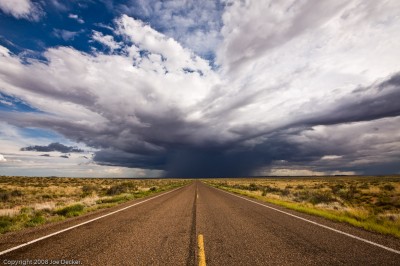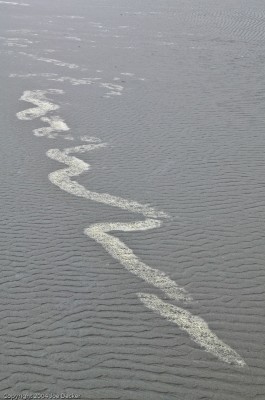
If you like this article, you can now get the book! Joe has expanded the “Tuesday Composition” series into an inspiring new ebook on composition, especially for nature photography. Check it out: The Tuesday Composition.
Last week I talked about S-curves, today I’m going to talk about the related and more general idea of leading lines. Leading lines are one or more lines in an image, typically diagonal lines usually coming up from around the bottom corners of an image. In particularly lines such as those formed by streams, railway tracks, roads, or geology along the ground. S-curves are a type of leading line, but here I’ll be contrasting them with lines that are typically straight or more simply curved.
Many of the things we said about S-curves apply equally well here, the lines seem to draw the viewer into the image, bottom towards the top. Similarly, I find that images that bring at least one of these lines from the lower-left are a bit more likely to work better for me, again probably related to the idea that the way we perceive images may be influenced in part by reading direction.
Sea Foam, Myers Beach provides a simple example of the power of even a broken and irregular leading line. My eye wanders up and back along the foam line in this image, and I get a sense of distance from that line receding to the upper-left. As much as I enjoy this image, it might be even more effective, if there was something interesting at the end of the line, upper-left.
More than S-curves, these sorts of leading lines are very effective at conveying a sense of distance. Often we’ll compose so that multiple leading lines converge to a point (or nearly a point), cueing us through perspective that the convergence point is very far away. With strongly converging leading lines, elements of the image near the point of convergence will not only appear (and likely be) far away, but they will also appear quite large. This makes leading lines an effective tool for creating a sense of scale for large, distant mountains or buildings, or, as in the case of this image from Petrified Forest, a thunderstorm.
In images with converging leading lines, the combined effect of direction (“into the image”) and the edges themselves (“along the edges”) pulls the eye to the convergence point very strongly. As a result, pay special attention to the parts of the image near the convergence point; the eye will be spending time there, and if that part of the image isn’t interesting the image as a whole will suffer as a result.
Distant Thunder demonstrates both these ideas, my eye returns to the rain underneath the thundercloud often when looking at this image. The outer edges of the road, the shoulder lines and the centerline all direct our eye to the bottom of the storm. In addition, even the horizon can and some of the shapes of the cloud seem to contribute some movement toward that center. Note how much more effective, though, the diagonal road lines are at moving our eyes around the image compared to, say, the horizon.
Also notice the way in which the perspective created by these converging, leading lines also helps us see the truly massive size of the thundercloud. The same image without those lines, without that perspective, wouldn’t have conveyed that sense of scale nearly as effectively.
Leading lines provide one of the simplest and most effective tools both for creating perspective within, and for directing the eye’s movement through an image. Next week, we’ll talk about an interesting way of capturing the eye in an area, the mysterious power of the circle.


Francis
10 Sep 2009great article, thanks!
Fotografo Matrimonio Milano
10 Sep 2009Leading lines are really important also in archtecture pictures. Thanks!
Joe Decker
10 Sep 2009Thanks, folks!
Torleif
11 Sep 2009Off topic: How about a favicon for this site? 🙂
da-y
13 Nov 2009I do love perspectives and lines in my photography.
Another article of circles is interesting too, bur finding lines is a bit easier :))
J. Boyance
4 Nov 2018Good read. Thinking of all this related to movies.